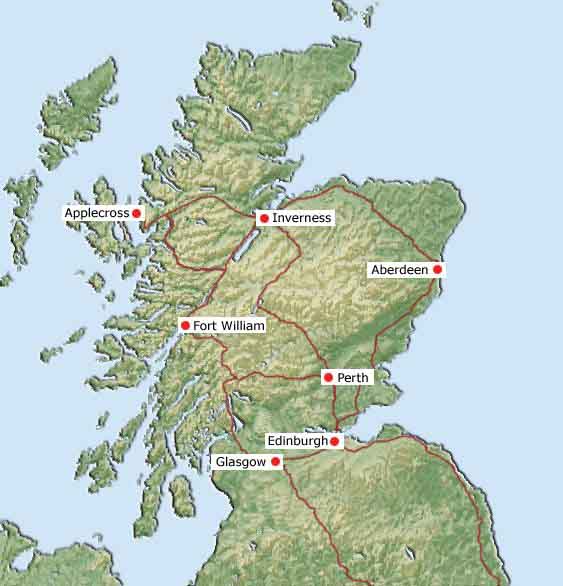Map Of Scotland
Explore Map of Scotland, a country that is part of the United Kingdom and Great Britain Island. Scotland Map showing counties, regions, towns & cities, major roads. Make use of this Map of Scotland to familiarize yourself with the location of major cities and tourist destinations within the country. Plan your trip around Scotland with interactive travel maps from Rough Guides. Use Rough Guides maps to explore all the regions of Scotland.
About Us AllPosters.com is the go-to destination for wall art and other fun visual products that express personal interests, life-long passions and of-the-moment obsessions. With a selection of over 3,000,000 images, AllPosters has something for every budget and decorating style. Find your favorite art prints from classic masters and discover up-and-coming artists. Browse the hottest posters in music, movies and sports. Explore our range of t-shirts and novelty gifts. You can even turn your own photo into an art masterpiece with MyPhotos.

Map Of Scotland 2017
Plus, choose from custom framing, canvas and wood mounting to truly make a piece your own — all high-quality at amazing prices.

Scotland Description On September 18th, the Scottish people voted to determine their nation's place in the United Kingdom. With 84.59% of voters casting their ballots, 55.30% voted in favor of remaining part of the union. The last Ice Age melted away some 10,000 years ago and Stone Age people began to arrive in Scotland from, and beyond. They built organized settlements in the and, the Northern Highlands and a few of the western isles.
The 'Picts' from continental as well as the 'Beakers' proved influential inhabitants. The ( 40,000 strong) began their invasion of the British Isles in 43 AD.
They called this wild land Britannia, and subsequently controlled it until their own empire began to collapse in 410 AD. During their reign the occupied what is now and, but Scotland ( then called Caledonia) was a different story.
When the Roman legions came north in 81 AD, they met fierce resistance from the 'Picts' and other local tribes. So strong was that resistance that Hadrian's Wall and two other walls were built to hem the barbarians in. Some 80 years later the legions retreated south as concluded this rugged land and its strong-minded people did not justify the high costs of occupation. In the 6th century, Gaelic speaking people ( the Scots) arrived in the Highlands from. Localized wars with the 'Picts' continued for three hundred years, with the determined 'Scots' prevailing. In the southern, a form of Anglo-Saxon feudalism gradually took hold, where royalty shares power with nobility, who in turn allowed common people ( serfs) to farm their land. The Lowlander tribal groups fought it, but soon capitulated, thus making way for their powerful family clans to form.
's Norman Kings long considered Scotland their land, and Scotland ( of course) firmly rebelled. Begrudgingly ( eventually) the Scots recognized that sovereignty. In the Highlands of the far north however, the pot was simmering, and in 1297, the long awaited drive for independence began. William Wallace led the growing resistance to occupation of Scotland.
After local raids and skirmishes, Wallace and his forces attacked the at the Battle of Stirling Bridge, killing thousands. After continually punishing the English on many fronts, Wallace, a brave and patriotic man to the end, was captured and executed ( drawn and quartered) by the English in London in 1305. Robert the Bruce, with the forces of William Wallace now behind him, became the real power in Scotland's long term fight for independence. He was crowned King of Scotland and battled the until he and his forces finally defeated them in 1314. Even in that localized defeat, still ruled most of Britannia, but victorious Scotland ( would not accept) that concept. The 1707 ( Act of Union) between and Scotland that created the Kingdom of was the byproduct of several factors, including the marriage of James IV of Scotland into the English Tudors; the martyrdom of Mary, Queen of Scots; James VI of Scotland succeeding to the throne of, an on-going civil war over English control of the land and the contentious effort to reform Catholics during the Protestant Reformation. For the next half-century the Jacobite movement made several attempts to restore Catholic Stuarts to the throne.
That ended with the defeat of Bonnie Prince Charlie in 1746. The Highlanders plan was finally crushed and they were forced to abandon their tartan kilts. During the Industrial Revolution of 18th and 19th centuries, Scotland became a regional commercial power.
Landowners forced tenants off the land ( the Highland Clearances), establishing large cattle and sheep farms. Soon coal mining, steel production and ship building continued the economic transformation.
The worldwide depression of the 1930's jolted the country, and by the end of World War II, Scotland's industries were in decline; unemployment reached record levels and hardship was the norm. Resiliency, no stranger to Scotland, brought positive change when the discovery of oil sparked a new national attitude. A litany of financial firms, electronic manufacturing businesses and helped perpetuate that economic resurgence. Though a distinctly separate country with strong levels of autonomy, the Scottish government ( Parliament) is not yet a completely sovereign entity. However, the desired ( total) independence from Britain has remained a hot-button issue across the land, and now seems possible. Scotland is certainly one of the most enchanting places on our planet, and a magnet for visitors in both ancient times as well as the 21st century.